1/ Cleethorpes UFO, September 1956
I live about a hundred yards from the Prom at Cleethorpes, and hence the reason why this one has always fascinated me since I was a kid. Problem is I’ve been through the local papers and there is no mention of the incident. It was September 22nd, 1956, and hundred’s of people saw a “glass sphere” hovering over the Humber. The RAF station at Manby near Louth observed the object, and it was estimated at 80 feet in diameter and hovering at 54.000 feet. It stayed there for over an hour when the RAF scrambled a couple of jet fighters to check it out, it then disappeared as soon as they closed in. Does anyone know what it was? I’m not usually into UFO’s and such like, but because it was unexplained and next to my house, I’d like to know a bit more.
2/ Cleethorpes Pier Fire, June 1903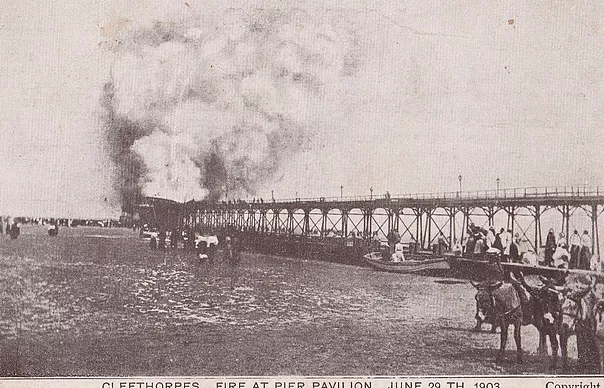
There was a gas explosion in the concert-hall at the end of the pier.
3/ Grimsby/Little Coates, August 1910
A lad from Little Coates, Thomas Edward Walton, nineteen years of age, went with his brother to the Alexandra Dock in Grimsby, for a swim. He got a cramp while in the Dock and was drawn by the current underneath a large raft made of wood which made his rescue extremely difficult, but his brother bravely dived in and tried to find him numerous times, but without success.
4/ Irby/Hatcliffe, May 1917
A young man by the name of Dunham Adlard from Hatcliffe was cycling through Irby next to a traction engine when his front wheel dropped into a pot-hole and he fell in front of the engine and was crushed to death.
5/ Brigsley Suicide, October 1907
Jennie Gladwin had gone to the greenhouse to pick some tomatoes and had been gone some time. When they found her she was hanging from a wooden beam in the greenhouse at Brigsley. (Where in Brigsley?)
6/ Habrough Station/Railway Hotel, July 1865 (Train Fatality)
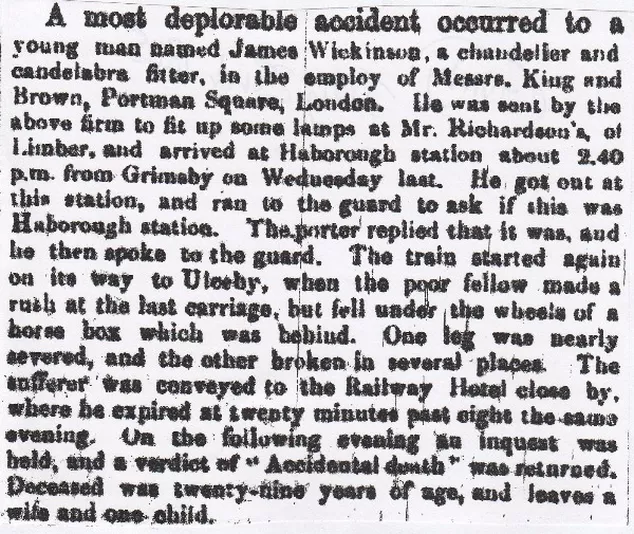
7/ Cleethorpes Station Fatality, July 1900
An eleven-year-old girl named Lizzie Williams from Thrybergh St, Denaby Main, was on a Sunday School outing to Cleethorpes and was about to get on the train to go home when she was shoved in the back and crushed between the train and platform. She was badly mangled and was taken to Grimsby Hospital, but died of her terrible injuries the next morning.
8/ Admiralty Wireless Station Death, Humberston, May/June 1909
This was at the time, one of the most sophisticated wireless stations in the whole of Great Britain, and the ever-increasing fear of spies wanting to glean information or even sabotage meant security was tight. Two men attacked a member of staff then made a swift escape in May 1909, and then the death of an electrician purely by accident the month after, really made the staff very jittery. The electrician was Michael Cooney from County Wexford in Ireland and he was electrocuted and died on the spot. When the coroner wanted to inspect the transmitting room, where the accident occurred they were refused entry by the Admiralty. They were sending messages to the North Sea ships on manoeuvres and it was top secret stuff. The transmitting room was fully charged, and all windows and doors had to stay shut but the switchboard operator said that certain appliances were not working and Cooney grabbed the door and went in. They shouted at him to stop but he received a shock and was badly charred on one side of his body. It’s thought he touched a live cable by accident. He died before proper medical attention arrived.
9/ Cleethorpes Golf Club Suicide? June 1908
The body of Mrs Jane Wearing aged fifty-eight of 25 Rowston Street, the wife of a retired farmer and baker John Wearing, was found face down in the Humberston Drain about twenty yards from the footbridge, half-way along the golf links. She was found there by a golf caddie named Percy Shaw at around five p.m. on Saturday. Is this the one near the Premier Inn or was the golf course still positioned across the road near where Pleasure Island was? The husband said she had been a bit depressed of late, and had an operation a few weeks ago at Hull and had asked him to write to his daughter in Scunthorpe and ask if he could go and stay with her for a few days. On Saturday morning he went to Grimsby and asked his wife what she would be doing and she replied that she was going for a walk. He returned after an hour and a half and found she had gone out. The neighbour saw her at two o’clock, and she told her she was off for a walk. The lad who found the body was looking for a golf ball when he saw her face down in the Drain near the footbridge. It is believed that she drowned in less than two feet of water, with the question everybody was asking “Was it an accident or was it suicide?”. There were no signs of assault and the wind was blowing hard that day, so it could have been an accident. The position in which she was found, floating lengthways, suggested that she just walked in and drowned herself, but it’s difficult to ascertain for sure. The verdict “Found Drowned”.
10/ Healing Suicide, June 1928
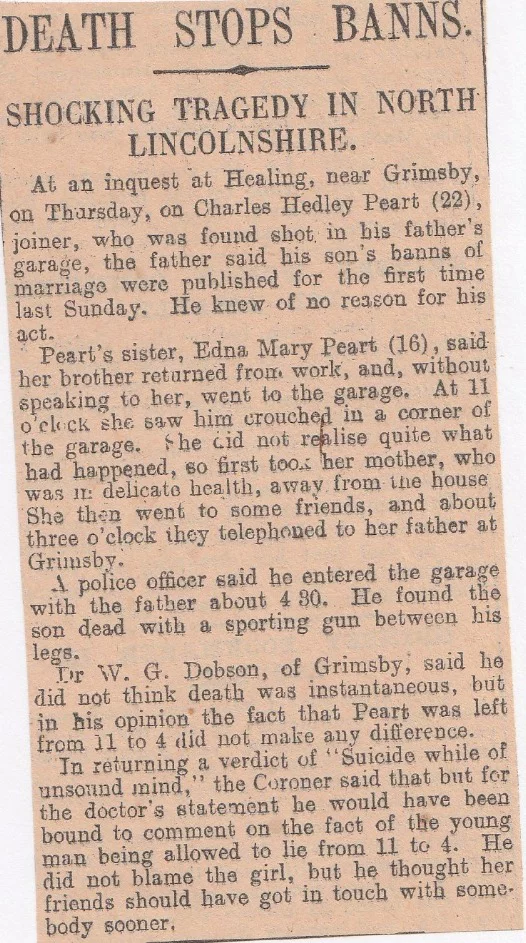
11/ Great Coates, May 1872 (Death Due to Lightning Strike)
A man from Laceby named Webster, was at work in a field in Great Coates with a harrow and four horses, when a storm passed over and he was struck by a lightning bolt. The horses all fell down and Webster received serious burns, and most of his clothes were burned off his body. One of the horses was killed as well.
12/ Cleethorpes/Tetney, March 1898 (Brig Ashore)
A brig has gone ashore near Tetney (Lock?) and the crew have all perished. The lifeboat at Grimsby was out for nine hours and couldn’t get near the Swedish vessel. The Pier had hundreds of family and relatives of the Grimsby fishing fleet wanting news of the vessels out in this storm. The seafront at Cleethorpes was badly damaged by flooding in dozens of houses along the front.
13/ Cleethorpes, August 1899
Mr J.H.Tasker from Grimsby drowned while taking a dip at Cleethorpes. A man from Leicester who accompanied him tried to save Mr Tasker, but he nearly drowned himself and was dragged from the water in an unconscious state, but he was given mouth to mouth resuscitation and he came to.
14/ Laceby, September 1860 (Fatal Accident)
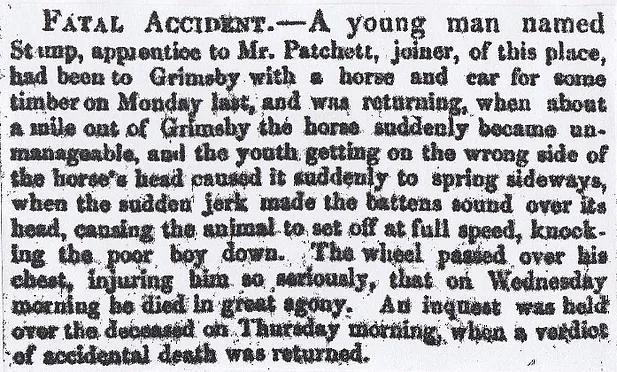
15/ Cleethorpes, June 1908 (Corpse Found on Beach)
A coachman was driving along the sands near the golf course at Cleethorpes at low tide and spotted a man’s body half-buried in the sand near the water’s edge. He told police and they removed the body. The corpse was so badly decomposed that any chance of identifying him is near impossible. Post-mortem results suggest that he had been in the water for at least a year, maybe more. He was wearing a pair of dungarees and some boots, which gives the impression that he was a fisherman who had been swept overboard while at sea.
16/ Admiralty Wireless Station, New Waltham, August 1914 (Spying)
Herbert Jankiewitz was arrested for being on the private property of the King, for the purpose of obtaining information, or spying as it’s better known. He was loitering around the Wireless Station at Peaks Lane in New Waltham and was warned by magistrates in Grimsby not to hang around Government installations at this present time. They search his lodgings and found no evidence of an incriminating nature there. Jankiewitz had been working for a local company for a year or so.
17/ Waltham, September 1914 (Spying?)
A Wesleyan preacher from Manchester who was holidaying in the Waltham area, took some photographs of the Wireless Station at Peaks Lane when he was arrested by police. He was charged at Grimsby then discharged when he claimed he was taking photo’s of the threshing machines in operation next to the Station.
18/ Barnoldby-le-Beck, (Riding Fatality) April 1845
William Smith had an obelisk erected in 1862 in his honour of his terrible riding accident in 1845. He was on a hunt and was huntsman to the Earl of Yarborough, a major landowner in the area. He was thrown from his horse when the beast jumped a ditch further than anticipated and he fell off and sustained serious spinal injuries. He was dragged into a house nearby and given medical assistance and lingered for several days, before finally succumbing to his injuries. The large obelisk marks the spot where he fell and is still there, opposite the churchyard at the top of Chapel Lane.
19/ Stallingborough Murder/Suicide, February 1871



20/ Waltham, December 1829
Thomas Dean Smith of Waltham, aged twenty-five years, was killed by a gun accidentally going off, which blew out his brains.
21/ Immingham, June 1907
70-year-old Mrs Batchelor the wife of a farmer from Immingham committed suicide by hanging herself.
22/ Immingham Docks, July 1914
At Immingham Dock on Monday, a labourer named Joyce was painting a ship, when he accidentally came into contact with a live wire and was electrocuted. Death was instantaneous.
23/ Cleethorpes Suicide, October 1904
An inquest was held upon the cause of death of James George Johnson who was a seaman, who committed suicide. He was landed from his ship due to illness and was taken home, where it was discovered that he had typhoid fever. His condition got progressively worse, and when asked why he didn’t take time off to get well he replied that he had a wife and kids to support and couldn’t afford to take time off. His condition was really bad by now and while his wife was out of the room, he got a pen-knife and stabbed himself in the throat.
24/ Ashby-cum-Fenby, July 1866 (I’m sorry Ashby residents but I’ve never seen an entire cricket team bowled out for less than double figures. Reverend Johnson bowled by Parsons?)
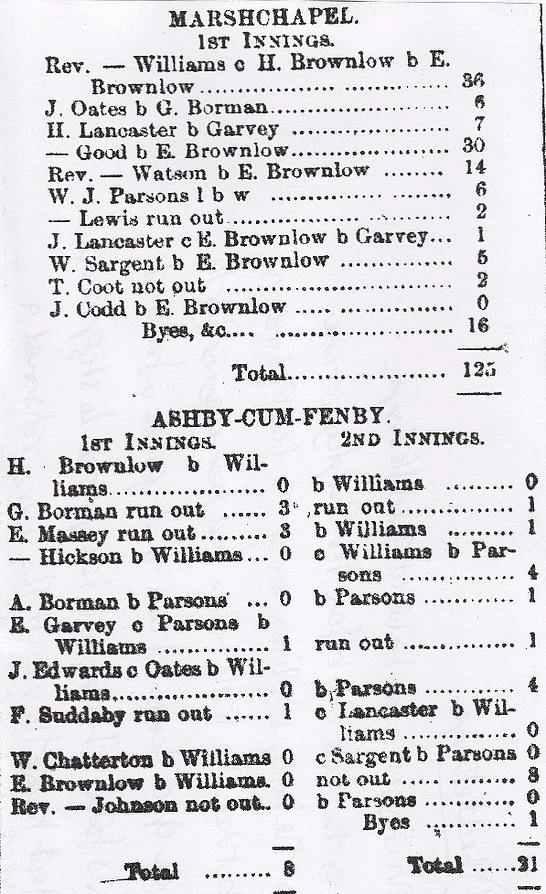
25/ Cleethorpes, January 1908 (Body Found)
John Nuttall a cockle gatherer, found the body of a man, half-buried in the sand on the beach near Cleethorpes. There was nothing on the corpse to identify him but a letter in his pocket was addressed to “J.Slight, s.s.Adelaide, Red Cross Fleet”. It is believed that a fleet of that name sails from Hull.
26/ Aylesby, October 1878 (Kleptomaniac/Drunken Vicar)
There is the story about smugglers such as Thomas Lumley, who in 1826 was fined a staggering £1500 for his illicit operations. He used to put his booty in a barn at Stallingborough near Immingham then move them to the church at Aylesby. This story though is about the vicar of Aylesby, the Reverend W.Rowson, who had a sudden urge to pinch someone’s coat at a Peterborough restaurant in 1878. But early in 1877, he was up in court in Gainsborough on a charge of being drunk and disorderly and assaulting a police officer as well. He was trying to see his children who were in the care of a Miss Travis, but seeing he was drunk, she wouldn’t let him in, but he grabbed the youngest boy in his arms, then proceeded to enter numerous houses, and then the Peacock Inn. He then came back later on and entered the house of Miss Travis where he fell over drunk and swore at the servants. Miss Travis got a servant to go and fetch a policeman, which he did, and when he was arrested, Mr Rowson took a swing at him, punching him in the face. He was fined 40 shillings for being drunk and got 3 months in prison for attacking the police-officer. Was he the vicar of Aylesby while all this went on or had he left the clergy?
27/ Cleethorpes, July 1905
The body of a teenage boy who was drowned at Cleethorpes while taking a dip in the sea, was found later on, then was identified as that of 15-year-old John Walker from Bulwell in Nottinghamshire.
28/ Healing Railway Crossing, October 1864

29/ Little Coates/Grimsby Town Hall, March 1893
During the counting of votes at the Town Hall at Grimsby, Mr C.F.Davy from Little Coates, agriculturist and vice-chairman of the Grimsby Board of Guardians, was seized with a fit of apoplexy (unconsciousness during a stroke). He was taken to an ante-room but died later on that evening. (Did he die at the Town Hall?)
30/ Cleethorpes Murder/Suicide, April 1908
A smartly dressed woman got off a tram in Cleethorpes with a couple of kids in tow and proceeded to walk down to the promenade. She took the baby in her arms and plunged into the water. The bodies were recovered, and whilst this was going on they heard the other child, who was about three years old, and crying whilst hanging on to the Prom railings. They rescued him and managed to bring him around with mouth to mouth resuscitation. (I will try to find a name).
31/ Great Coates, July 1871 (Botched Abortion)
An inquest on the body of Betsy Moore aged twenty-one, domestic servant, was held at Great Coates. Her death occurred one morning when she took a noxious drug taken to cause a miscarriage. The evidence of a fellow servant proved that deceased was four months pregnant and that she had managed to purchase an ounce of a powder called colocynth, the whole of which she swallowed. The Coroner said that in attempting to destroy her child she had killed herself, and as it was the secondary result of a first illegal and felonious act, it was wilful murder. The verdict was felo de se, and the body was buried within 24 hours.
32/ Humberstone, (Mother Nurses Dead Child) April 1861
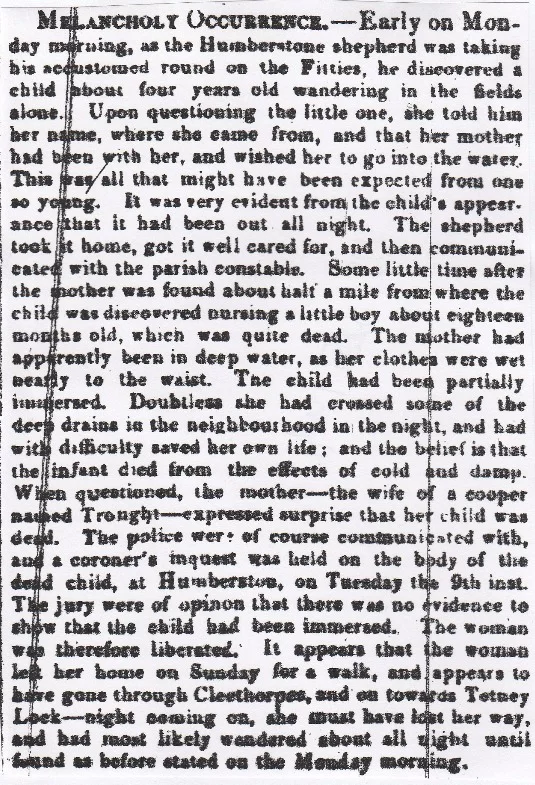
33/ Cleethorpes Railway Station Death, August 1865
Mr Simons, a shoemaker from Hull, was attempting to get into a train carriage at Cleethorpes Station, at 7-30 p.m., while it was still moving away. Inevitably he missed the carriage and fell under the wheels and was badly mangled. He was badly lacerated between his legs and his spine and ribs were broken. The station master tried to stop him from climbing on the train but he ignored them, and as a result, he leaves a widow and a child. The inquest at the Refreshment Rooms ended with the jury returning a verdict of “Accidental Death”.
34/ Cleethorpes, July 1909
Charles Robinson aged fifty-six, who was a wealthy recluse, committed suicide by hanging himself. A verdict of “Suicide during temporary insanity” was returned.
35/ Combe Street, Cleethorpes, July 1910
Just across the road from Blundell Park lies Combe Street. It was here that Edward Jackson aged sixty, a Freeman Street greengrocer, was discovered hanging from a hook attached to an outbuilding door. A pair of steps tipped over, were next to him, suggesting that he used these to help hang himself. He had a slight tiff with his wife that morning, with his wife saying that he needn’t come back anymore. He had been ill for quite a while and when he was drunk he became morbid and threatened to kill himself on several occasions. He left a note, addressed simply to “The Coroner”:-
“I have had a rough time, I have had gangrene on my foot and lost a toe. Mrs Jackson disposed of the business against my wishes, and her and my oldest daughter have tried all they know to dispose of me, as I am at present suffering from a cold on my chest and from the effects of water being sprinkled in my bed at nights, making it damp, so that I shall get a cold. They have a great wish to get rid of me altogether and that I should not come with them at all. Since I have been with them they have taunted me that I dare not take my life. At last, I took 2 ounces of laudanum a few weeks since, but I was sick and got shut of a lot of it.” It goes on to say:- “Mrs Jackson’s ex- husband’s brother had orders to clear me out with threats of killing me if I ‘m not out by Wednesday next. So I am clearing out. I am harassed to death, with one and another of them. Mrs Jackson says I dare not do it- Ed Jackson”.
A neighbour, Benjamin Savory, living at 60 Combe Street, saw him at 10-30 one night and mentioned it was cold and that he should go in. He went out just over an hour later and he was still there so he asked him to come into his house, but he refused. When found hanging in the outhouse, he was cut down. The post-mortem revealed he had been dead for six hours.
36/ Wold Newton/East Ravendale Murder, May 22nd, 1869
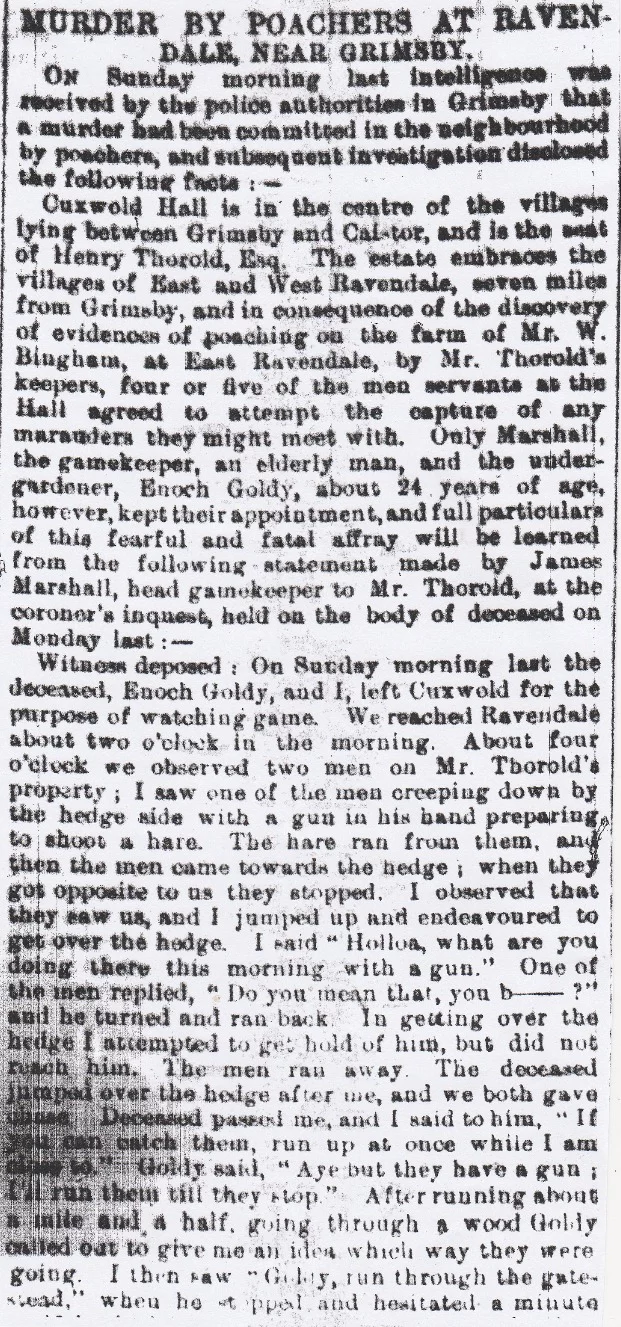


June 5th, 1869 (Wold Newton Murder)
George Taylor, at the magisterial investigation, deposed that the prisoner Charles Traves wearing a pilot cloth coat, and to Robert Traves wearing a velveteen coat. Both coats were found on Monday last by this witness. They were hidden under a hedge among the nettles. Police are still searching for the guns.
July 17th, 1869
On the 8th July, the guns were found by some labourers who were weeding a wheat field. They were found near “Twelve Acre Screed”, in amongst some thickly growing ivy by a Mrs Drew. It is about a mile from the murder scene and three miles from where the coats were found. The prisoners, Charles and Robert Traves will be tried at the Lincoln Assizes on the 24th of July for the murder of Enoch Goldey.
July 31st, 1869
The verdict of the jury was “Guilty of Manslaughter- and was sentenced to seven years penal servitude”.
Enoch Goldey was buried at St Nicholas churchyard in Cuxwold with the gravestone reading thus:-
“In Memory of Enoch Goldey, who having volunteered to assist the keeper was cruelly murdered by poachers on the morning of 16th May,1869, aged 24 years.Take ye heed, watch and pray, for ye know not when the time is. Erected by Henry Thorold of Cuxwold Hall to his respected servant”
37/ Waltham, May 1880 (Dead Body in Ditch)
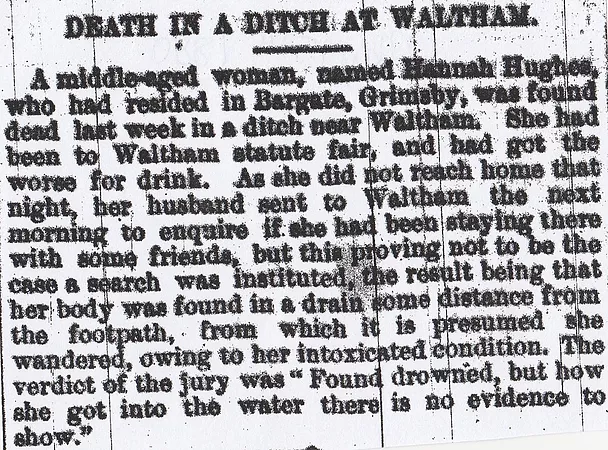
38/ Cleethorpes, January 1829 (Eight Drowned)
There were three vessels lying off the coast of Spurn Point when the captains of the three decided to go and spend some time with Mrs Richardson and her family at Spurn Lighthouse. Captain Sales, Samuel Healas, and George Briggs left their respective ships late Sunday morning, and in one boat along with three other men and a boy, all belonging to the “Phoebe”, one of the boats moored, plus another man from another of the boats. They went to Spurn Lighthouse and spent some time with Mrs Richardson and family, then when leaving were heard discussing going cockling at Cleethorpes. Nothing more was seen or heard from them until their bodies began to wash up on the beach at Cleethorpes. It is believed that all eight of the men have been drowned, along with a bag of cockles which was found near to where the bodies were washed up.
39/ Cleethorpes, March 1909 (Abandoned Child)
A young who was supposedly abandoned in the middle of nowhere by his mother firstly, then by a carter who drove him out into the country and left him. An officer from Market Rasen brought the lad into Cleethorpes when he was found wandering the countryside in a daze and suffering from hunger. He told him his name was Thomas Meake, and his father who was a contractor in Clerkenwell, London died six years ago and since then he and his mother had been roaming the country. About six weeks ago they both arrived in Cleethorpes and rented a house where she kept him locked in the attic never letting him out until last week. He was driven out to the Wolds in a milk-cart and then dropped off at a farm, then was picked up by another cart and driven way out into the countryside and dropped off by the carter who told him he be back soon but never arrived.
40/ Habrough, April 1910 (Body on Tracks)
A man’s body was discovered in a mutilated condition on the Great Central Railway at Habrough near to Immingham Docks. He was identified as Arthur Hales, a labourer from Wisbech in Cambridgeshire, and he had been to the Brocklesby Races and presumably got lost and was then hit by a train.
41/ Hatcliffe/Brocklesby (Fatal Accident) February 27th, 1869
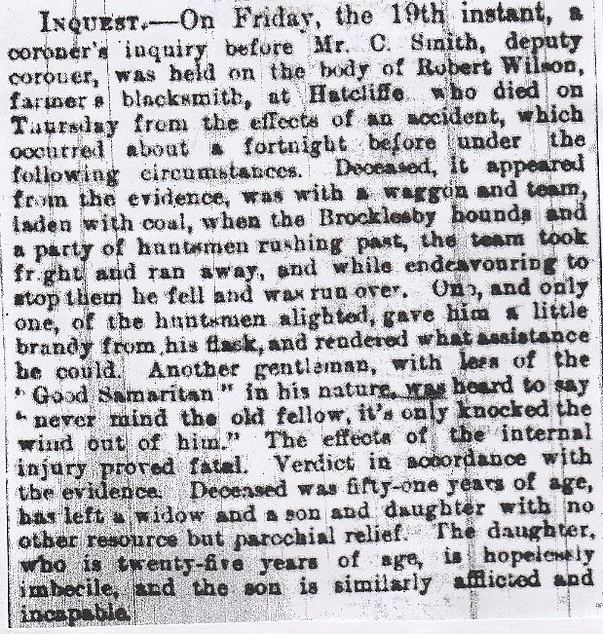
Hatcliffe ( Death Due to Hunt) March 6th, 1869
Apparently, the hounds of Lord Yarborough didn’t rush past the waggon of the deceased, thereby causing his death. They were approximately half a mile from where the accident occurred, at the time and the huntsmen had no idea that anyone had died until a long time after Robert Wilson had expired. The horses had been scared by the hunt followers. The vicar of the parish had told the Earl of Yarborough about the accident and his Lordship sent £5 to the widow as a token of his esteem.
42/ Waltham, September 1914 (Motor Accidents)
Grimsby skipper John Emery was killed at Waltham when the motor-car which he was driving overturned. His wife and two friends were passengers, and they were all injured, his wife being in a critical condition. Mr Emery had swerved to avoid another vehicle when it tipped over and crashed onto the roadside.
Private Brown of the West Riding Regiment was killed when he fell from a motor-bus in Waltham on Saturday night.
43/ Cleethorpes Drowning, July 1915
Soldiers bathing from a boat at Cleethorpes one Sunday afternoon, noticed that Private John Thomas Ferguson was struggling out in the water. They managed to rescue him but mouth to mouth resuscitation failed and he died on the beach.
44/ Irby Dale Bogle, March 1885
At the village of Irby near Laceby, there were tales of an apparition being spotted in some woods near the village. A young man in the late 19th Century recalls that the village would be disturbed by hideous noises emanating from the woods with the sounds akin to the sound of a woman screaming. The story was that the ghost of a young woman who was brutally murdered by her sweetheart and now haunted the woods and dale near the village and now known as the Irby Dale Bogle.
45/ Humberston (Fatal Accident) March 1866
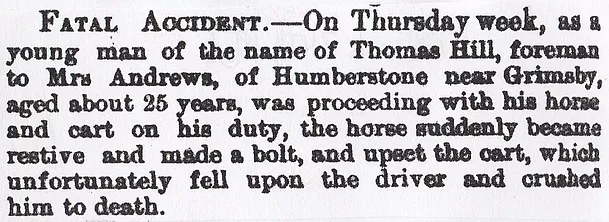
46/ Cleethorpes Zeppelin Raid, April 1st, 1916
Without a doubt this was the worst disaster in Cleethorpes and district’s history, when on April 1st, 1916, the Zeppelin L22 dropped bombs on several areas around the town and surrounding villages, with one bomb scoring a direct hit on the Baptist Chapel on Alexandra Road in Cleethorpes, killing thirty-one N.C.O’s of the Manchester Regiment who had just been billeted there. Another of his bombs hit Sea View Street and another landed at the rear of the Town Hall (where the Council Offices are). There is a memoriam in Cleethorpes Cemetery to all thirty-one who died that night.
47/ Stallingborough, July 1875 (Concealed Birth)
Mary Ann Hardy aged 22, servant, was appearing in court for unlawfully endeavouring to conceal the birth of her female child at Stallingborough on the 7th April. She was the cook in the service of Mr Sutcliffe and her fellow servants suspecting she was giving birth to a child called in a midwife, to whom the prisoner acknowledged she had had a child and that it was born dead. The judge said there was no evidence of an attempt at concealment and directed the jury to acquit the prisoner.
48/ Cleethorpes, February 1910
A Swedish woman named Svendsen was summoned for having failed to take proper precautions, to prevent her 6-year-old child being burned to death. They had moved into the house the day before and had no fireguard. The child’s clothing caught fire when she stood near the fire and with the mother trying to extinguish the flames with her bare hands. The child ultimately died of its’ injuries, and the mother’s hands were badly charred.
49/ Goat Hill/Humberston, September 1867 (Does anyone know where Goat Hill is? I found North Goat which is near the Fitties area. Presume its somewhere near Pleasure Island used to be.

50/ Cleethorpes, June 1909 (Two Girls Drown)
A nine-year-old boy named Jack Thomas attempted to save the lives of two 6-year-old girls, Gladys Yates and his own sister, Elizabeth Thomas, who had fallen off a plank of wood which spanned a brick pond in Cleethorpes. Another lad started yelling out and Jack came running up and dived in after Gladys and grabbed hold of her and tried to get her to the bank, but he couldn’t quite keep hold of her, and she drowned. Then he saw his sister’s hat floating on the surface and dived down to look for her, but she too had sunk to the bottom of the pond. He tried again to dive under, but he was exhausted and was in danger of drowning when a man named Toole jumped in and pulled him out.
51/ Healing Manor Ghost-Date unknown
Unfortunately when someone told me about Healing Manor the first thing I now remember about it was the fact that it was used as a place to grow large amounts of cannabis. But if that wasn’t the only strange smell of smoke in this building, then apparently the ghost of “Viscount Portman” was seen and spotted walking the halls and rooms of Healing Manor, and was followed by a smell of pipe tobacco. Then there’s the picture of Miss Lincolnshire outside the building with what appears to be a ghostly figure looking out of a window just behind her.
52/ Waltham Suicide, November 1909
A middle-aged woman named Martha Turner aged48 resided with her mother, brother and sister, at Ivy Cottage in Waltham and decided that suicide would be her best solution. She had been depressed of late and had just had a bout of influenza, but she went to bed one evening in a good mood. The following morning her sister went to the kitchen to make breakfast and she found a note of the kitchen table, which simply said – “You will find my body in the pond at Mr Toplass’s field”. Her brother and a neighbour rushed to the pond and found her there, having drowned herself.
53/ Habrough,(Burned to Death) February 1900

54/ Stallinborough, May 1915 (Stray Bullet Kills Man)
While some soldiers were busy having some target practice at Stallingborough Butts, a young man named Pearce was struck by a stray bullet, killing him. The victim was 25-year old William Henry Pearce from Grimsby, who was on a small vessel in the Humber when he was hit by the bullet. Staff at Grimsby Hospital tried to save him but he died that evening.
55/ Laceby, November 1976 (Car Crash)
Over the years the Laceby bypass has seen lots of accidents and fatalities over the years. This one was 21 year old Stephen White who worked in Scunthorpe but lived in Grimsby, and his Ford Capri smashing into a stationary lorry. The lorry had just pulled out of Laceby village and was waiting in the central reservation to turn right towards Laceby roundabout. He was killed in the collision, but coincidentally his brother in Middlesbrough had a motorcycle accident just four minutes before his accident.
56/ Immingham, May 1914 (Newly-wed Commits Suicide)
26-year-old Walter Stamp, a shunter on the railway, killed himself after being married for only four days. The inquest was held at Immingham with his wife having to be helped into the room, so frail was her condition. Her husband told her that he had managed to save up £60 and the wedding had cost £10, leaving £50 spare. They were moving the furniture into the house when he told to go and get the £50 from upstairs, as the removal had to be paid. She went up to look for it but there was no sign of any cash, and when she told him he shrieked “I’ve been robbed”. A few moments later she went up to see if he had found it but he was laid on the bed with his throat slit from ear to ear. He left her a scribbled note saying:- “Dear Wife. Just a farewell….”. Police think that he had meant to write more than this but heard his wife coming and then cut his throat.
57/ Waltham, February 1886 (Gun Accident)
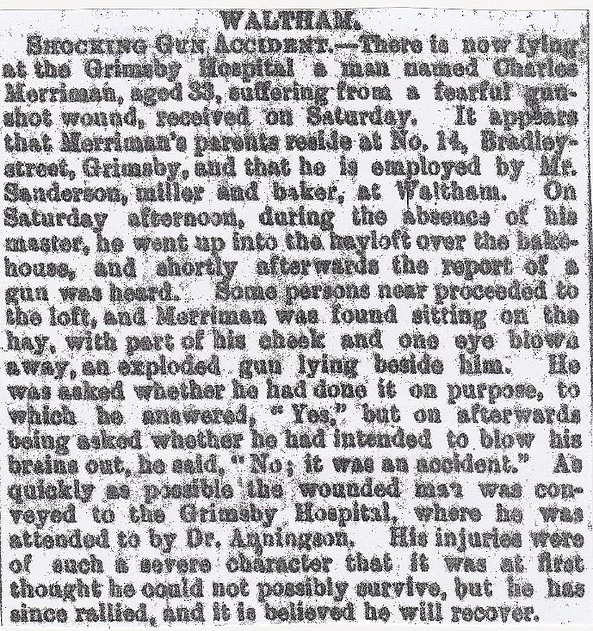
58/ Great Coates Suicide, March 1876
Henry Kirton Walsh, a farmer from Great Coates aged twenty-three, had a large farm in the village had been despondent of late due to him not accessing entry to a house on his property, which needed repairing. (I wouldn’t kill myself for it though!). He bought some prussic acid from a chemist in the Old Market Place in Grimsby saying he was going to poison a dog. That evening he took the poison and went to his bedroom at his groom’s house at Great Coates, where he was staying. He was discovered in a semi-conscious state by his groom later on when he heard the thud of the body hitting the floor. The post-mortem revealed that he had taken enough prussic acid to kill four men and it was judged as a suicide whilst temporarily insane.
59/ Waltham Suicide, April 1859
On Tuesday last this quiet little village was the scene of great excitement, by a report which proved too true, namely, that Jane Allenby the wife of a labourer, had committed suicide; she was found suspended in the chamber quite dead ; she had been some time very much depressed in spirits and left an infant seven weeks old. An inquest was on Thursday- Verdict “Temporary Insanity”.
60/ Daubney Street, Cleethorpes, June 1904 (Murder/Suicide?)
This is a weird story about 24-year-old Charles Henry Smith, who lodged at 27, Daubney Street in Cleethorpes, with a middle-aged woman named Mrs Prior. Now Mrs Prior had her daughter-in-law, Alice, living with her while her son was at sea on a trawler. Here’s where you think “I bet they were carrying on with each other”, but you would be wrong. Charles married Eliza Brown and the Priors had just bought a grocers shop in Freeman Street and moved there, so they let the house to the Smiths. Eliza Smith and Alice got on like a house on fire and constantly saw each other and it was on one of these visits, that the tragedy occurred. Charles was minding his own business while the two women enjoyed a cup of tea and a gossip. At around 9-15 p.m., Eliza popped to the chippy for everyone and when she returned ten minutes later, she found Charles on the floor with a self-inflicted gunshot wound to his left eye. Alice was still alive, though only just, and had a bullet in her temple, but at 3 a.m. at the local hospital, she expired. The question that has always remained has been,”Was he seeing Alice behind Eliza’s back? or Was she blackmailing him? A witness supposedly heard the two of them talking the day before, and Smith angrily growled: “If you do tell, I’ll do it”.
61/ Cleethorpes, August 1878
While coming up the Humber on Saturday, Richard Penny, master of the smack “Major Seddon”, saw a shrimp boat suddenly capsize in a squall, immediately outside the Cleeness Buoy. Mr Penny at once sailed to the place of the casualty but could see no signs of life or property. The boat was cutter rigged and all under sail.
62/ Cambridge Terrace, Cleethorpes, July 1877 (Suicide)
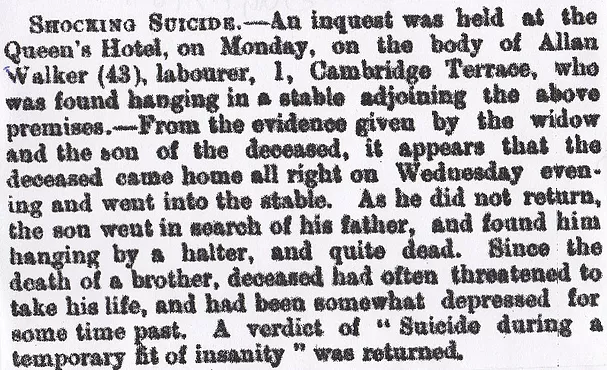
63/ Cleethorpes, June 1884 (Died Washing Windows)
A very serious accident happened to Mrs J.Mumby of Sea-bank Road, Cleethorpes at about 11 a.m. on Friday last week. She was engaged cleaning the outside of a window on the third storey when she made an unfortunate slip and fell to the ground, a distance of nearly thirty feet. A broken thigh, a smashed foot, and other injuries were the immediate consequence. It appears that Mrs Mumby had only just prior to the accident stopped the servant girl from cleaning the window because of danger attending the work, and had undertaken the task herself. The unfortunate woman expired on Wednesday.
64/ Healing/Great Coates, March 1861 (Body on Rails)
At about 7-30 p.m. on Monday, a waggoner named Edward Smith discovered the body of a man upon the Manchester, Sheffield and Lincolnshire Railway, between the villages of Great Coates and Healing. The body was that of William Gainsborough aged thirty-six, the son of a farmer at Great Coates. He had evidently been struck on the back of the head by a passing engine and thus killed. The deceased was conveyed to his father’s house with an inquest was held at Great Coates on Wednesday. The deceased had been ailing and in a low frame of mind for the last six weeks.
65/ No.124, Grafton Street, Cleethorpes, June 1886
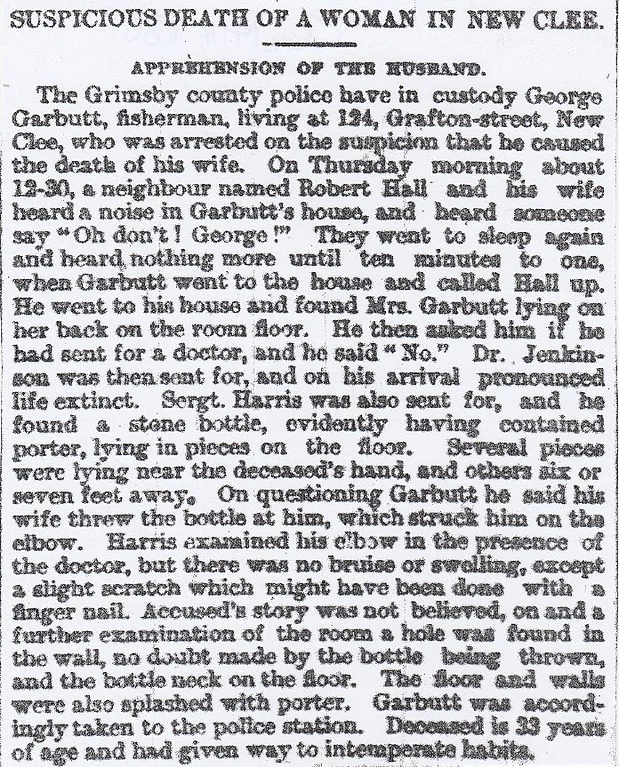
66/ Cleethorpes Railway Station Death, October 1887
Not unusual for Victorian times that train stations had several deaths and injuries in each one, as Health and Safety was not yet invented. The larger ones, such as Kings Cross, Paddington, Euston etc, also had a large number of suicides and bizarrely common, was the posting of dead infants, which used to end up decaying in “Lost Property” offices around the country. The station at Cleethorpes had a few accidents, and these are the ones I found.
An inquest was held at Cleethorpes on Wednesday upon the body of a man called Newmarsh, a lamp-cleaner in the employ of Manchester, Sheffield and Lincolnshire Railway Company. The evidence showed that deceased was employed on Monday night removing lamps on the top of the carriages of a train, which was in Cleethorpes Station. The train was moving at the time and Newmarsh lost his footing and fell between the carriages. He was frightfully crushed between the buffers and he died almost immediately.
67/ Cleethorpes Railway Station Fatality, March 1870
An inquest was held on the body of John Greenhaigh of Manchester, aged twenty-four. He was employed as a painter by Messrs Peter and William Mitchell of Manchester, who were contracted to paint the stations of the Manchester, Sheffield and Lincolnshire Railways, were painting the woodwork on the roof of Cleethorpes Railway Station. The shortened version of the story was that he fell thirteen feet when a ladder was taken away and landed head first causing serious head injuries. He was rushed to Grimsby Hospital where they tried to stem the blood from the vessel that burst in his head. The inquest said that the ladder he fell from was not moved maliciously but done thoughtlessly and indignantly. The man who took the ladder, William Mitchell, was blamed for the accident by the jury. The end verdict was one of “Accidental Death”.
68/ Cleethorpes Railway Station, February 1877 (Fatal Accident)
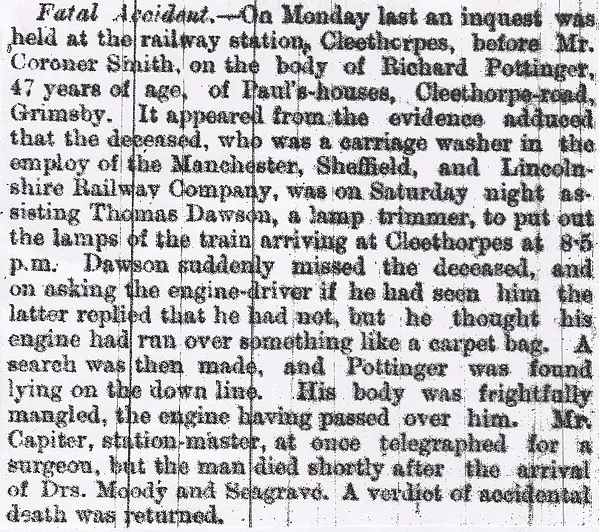
69/ Weelsby, March 1861 (Body Found)
On Thursday morning, the 14th, the body of a man was discovered lying on the rails of the Great Northern Railway near the tunnel in the parish of Weelsby, about a mile from Grimsby Station. From papers found upon the body after its removal to the mortuary, it was discovered that deceased had served in the army in the Cape Mounted Force, an order of discharge being found in his pocket. The unfortunate man, whose name was Henry J.Ashton, had been seen in Grimsby the previous evening, and it is supposed that he had proceeded to walk along the line and was overtaken by the 8-20 mail to London. When discovered his head was found to be severely cut by the wheel of the engine and also one of his legs.
70/ Dolphin Hotel Death, Cleethorpes, September 1869
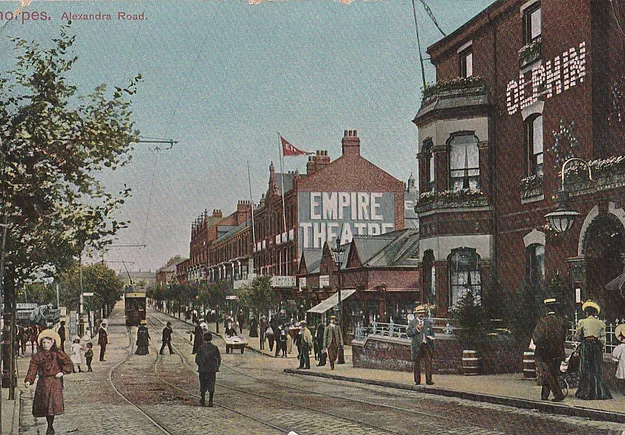
An inquest was held at the Dolphin Hotel, Cleethorpes (See above, right-hand side) on the body of Mr Joseph Willan, coal merchant, from Dartmouth Street, Birmingham. He was about 62 years old and came to Cleethorpes on Saturday evening. He arrived at the Dolphin Hotel had a hearty supper and a glass of wine, and went to bed at 7-30 p.m. At nine a.m. on Sunday the chambermaid knocked on the door and asked him about breakfast to which he replied that he would order it when he got up. Again at 1 p.m., she knocked on his bedroom door, but receiving no reply she opened it and found him dead in bed. Apparently, he had heart and liver disease and that a large vessel in the liver had given way and sent the blood into the cavities of the body. Death would therefore be the effect of haemorrhage.
71/ Little Coates, December 1884 (Body in a Well)
An inquest was held at the home of Edward Wardle an engine driver, on the premises of the Grimsby Waterworks Co, on the body of George Smith aged twenty-five, a labourer in the employ of Mr Davy, farmer, at little Coates. Deceased had been working in a turnip field with labourers but had failed to turn up for work on Thursday afternoon, inquiries were made as to his whereabouts and it was ascertained that he hadn’t been seen since 7 o’clock that morning. Mr Wardle was told the bare facts and then remembered seeing a hat in a diseased well on the Company’s premises. The hat was shown to friends of George Smith and they said that it belonged to him. The well, which was twenty feet deep was dragged, and Smith was found at the bottom. It was stated that he used to suffer from staggering fits and that in all probability he had a fit while passing the well on his way to work then plunged in and drowned.
72/ Wollaston Road Murder, Cleethorpes, March 1919
A murder was committed at Wollaston Road, the victim being a 52-year-old woman by the name of Sarah Robinson, who along with a friend Mrs Evans was also attacked. The murderer was a 50-year-old Joseph Woodhall, an ex-soldier from Wigan who had viciously beat them both over the head with an Indian club. Mrs Robinson had set up a soldier’s home (Brighton Street) and Mr Woodhall was her lodger and the two had become very close and he was employed by her to help run things. Woodhall and Mrs Robinson went to see Mrs Evans at Wollaston Road one evening and all three were in the kitchen enjoying a bite to eat when he attacked the both of them with the club. He legged it and left the body of Mrs Robinson drenched in blood and Mrs Evans was left unconscious. They were taken to the hospital and Mrs Robinson died there a few hours later. The police were now on a murder hunt, but in a surprising twist, the murderer, who was bare-footed and wrapped in a blanket, handed himself into the Station-master at Waltham. Sarah Ann Robinson was buried at Cleethorpes Cemetery and the whole sad affair was believed to have been about some money. (Been to the grave- small headstone near a tree, with no mention of her brutal demise)
73/ Cleethorpes Boating Disaster, August 1867

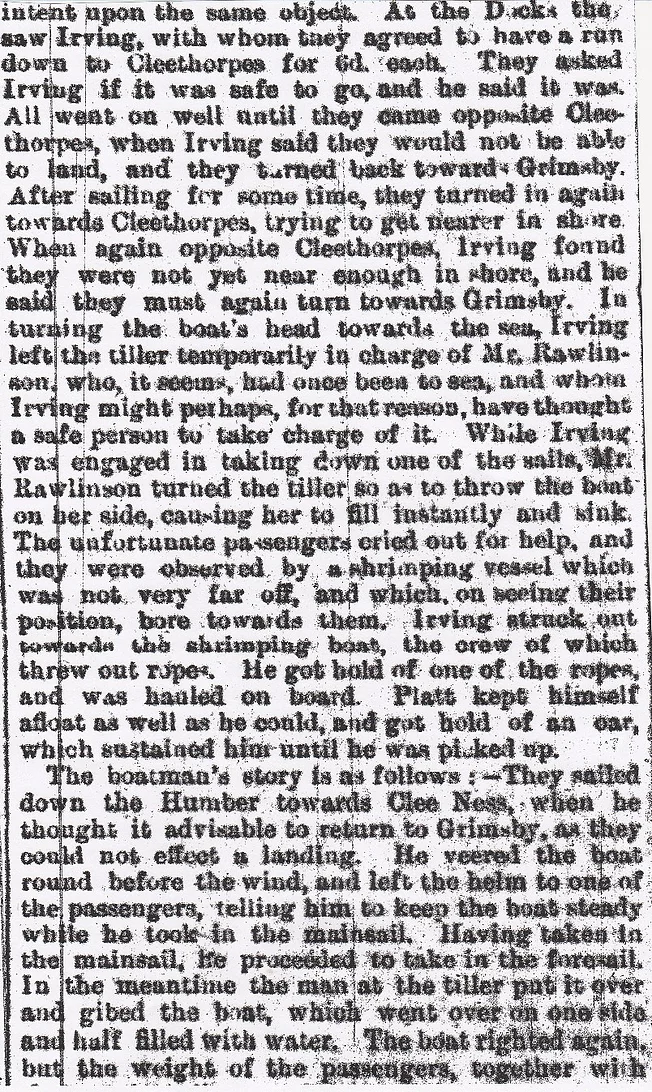
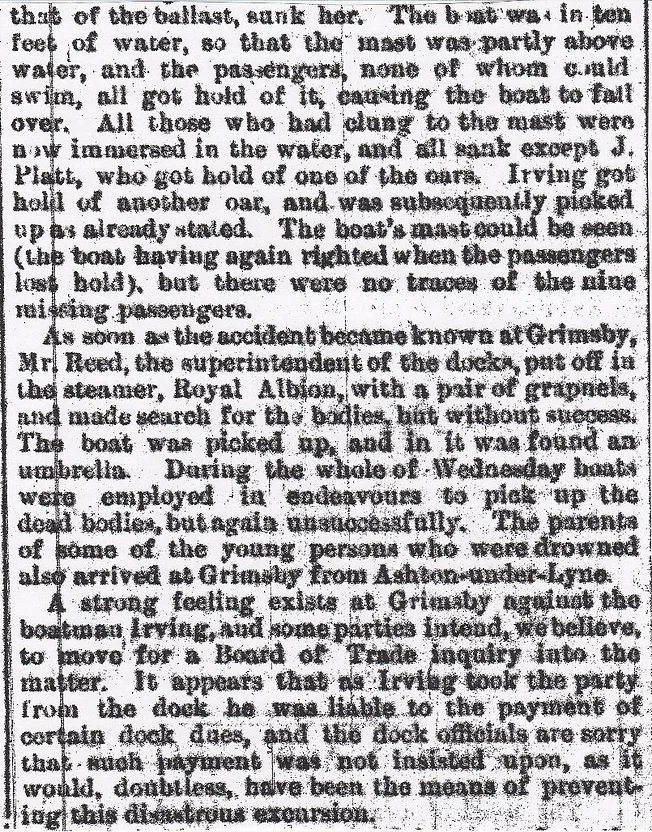
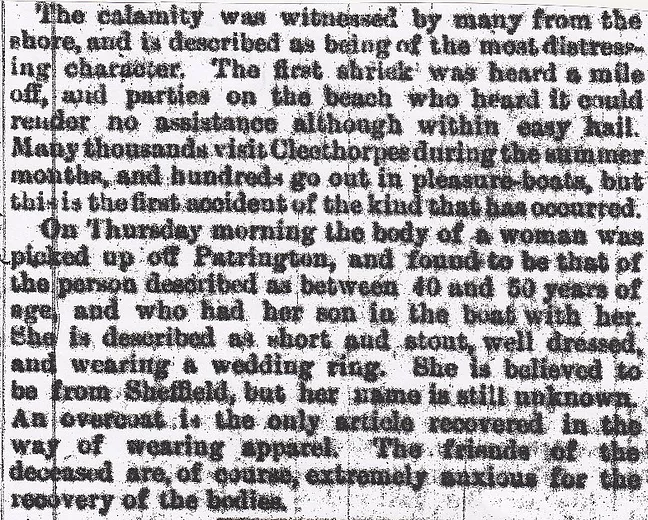
74/ Cleethorpes Boating Disaster, August 31st, 1867
Five bodies out of the nine have been recovered and three inquests have been held. The first at Patrington Haven on the body of Priscilla Thickett aged fifty-three, from Sheffield, whose body was washed up there a day or two previously and was recorded as “Accidental Death”. Four bodies were recovered on Monday; Thomas Platt of Ashton-under-Lyne and the others were the Mr and Mrs Rawlinson of Ryecroft near Ashton-under-Lyne and another female named Louisa Saxon. An inquest was held at Cleethorpes on the bodies of Louisa Saxon and Mr and Mrs Rawlinson and verdicts of “Found Drowned” was returned. The inquest at Maddison’s Hotel, Grimsby, heard evidence that the boat hadn’t been built to carry more than six people. The verdict of Thomas Platt was “Accidentally Drowned-but the jury express the opinion that death was caused by mismanagement of George Irving and this can be little short of the crime of manslaughter and he has had a narrow escape from being committed to the Assizes on a charge of manslaughter. The boat was ordered to be destroyed.
75/ Scartho, May 1861 (Two Deaths)
It is our painful duty to report two deaths in the family of Reverend Williams of Scartho, who lost two sons within a week. One, a fine youth of fifteen years of age, went home from school on Wednesday apparently in good health- indeed he had been playing cricket that afternoon-and on Friday he was a corpse. The other had been ailing some time, died after the day of interment of his brother. The cause of death was a violent fever accompanied by diphtheria. The health of another child is in a very precarious state but hopes are entertained of its recovery.
76/ Suggitts Lane Crossing Death, Cleethorpes, September 1894
A young lady in her twenties named Miss Rheta Betsy Suggitt, who was the daughter of Mr W.S.N.Suggitt of Suggitt’s Lane, a fish merchant by trade, was found on the railway line near her home.She was a teacher at Silver Street School and used to go down to the Pier and Promenade for an hour or two in the evenings. Her father went to smoke his pipe and look out for his daughter (at the level crossing) on her way back along the railway line when he saw a black object on the tracks. He realised it was a body of a woman, and got his neighbour named Robinson to give him a hand in moving her. When the father brushed the hair from the face he saw it was his own daughter. after Robinson had told him”It’s your poor Rheta”. The station-master at Cleethorpes Station, Harry Hewitt, said they wished each other Goodnight when he saw her walking along the platform. Then later, the 9-32 arrived from Hull and he said there was something the matter at Suggitts Lane and thought somebody had been knocked down. When the engine was checked to see if any impact was visible they found human hair on the hand-brake screw. Miss Suggitt’s clothing was torn, but not cut, and there was a fracture of the skull just above the left eye. There were bruises and abrasions all over the body and cuts on both legs, suggesting she had been knocked down by the engine. The jury verdict was the deceased was killed whilst passing over the level crossing near Suggitt’s Lane.
77/ Scartho, September 1869 (Concealment of Birth)
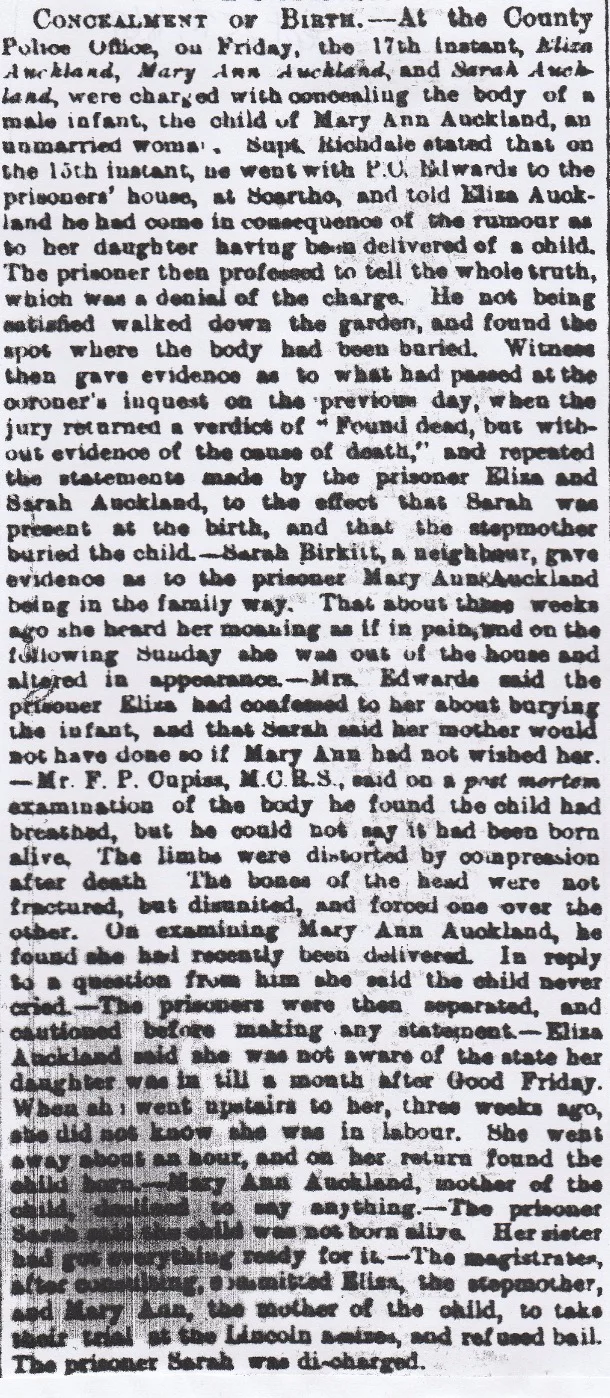
Eight months later in May 1870, Eliza Auckland was back in the newspaper again with this tale of a strange relationship. Try to keep up with me: it took me a while to figure it out.
The women Auckland and Riggall, who were committed on Monday last at Grimsby for extensive shop robberies, besides being sisters, occupy an odd position of relationship. Eliza Auckland’s husband first married HER mother, who was a widow with a family, both prisoners being her daughters. On the death of his wife, the man Auckland married one of her daughters. Thus his wife is his step-daughter and she is stepmother to her sister, who is sister-in-law to her stepfather and aunt to her sister-in-law. What a bloody rough family that was, in its day!
78/ Near Grimsby, (I’m Guessing a village nearby. Anyone know where?) October 1914
Some Territorials near Grimsby found a man lying in the roadway, then further along the road was a woman bent over a railway gate, and they both had their throats cut from ear to ear. The woman was rushed to the hospital and was still conscious enough to tell police that she was from Woodseals in Sheffield and she was married. She also told them that the man who was present nearby was also from the same place and they had made a suicide pact.
79/ No.72 Montague Street, Cleethorpes, (Burned to Death) February 1895
Burning fatalities amongst children have latterly been most frequent in Grimsby and the neighbourhood. Another case has just occurred, the last victim being John Chapman Budd aged four, the son of John George Budd of No.72 Montague Street, New Clee.
80/ Chapman’s Brickyard, Cleethorpes, March 1881

81/ Laceby, April 1845 (Poisoning)
Jane Bell, from Laceby near Grimsby, was committed to prison on a charge of poisoning her husband with arsenic. (Did she kill him//If so what happened to her?)
82/ Laceby, July 1899 (Traction Engine Fatality)
One Saturday afternoon, a couple of lads were riding on the shaft of a waggon which was being pulled by a traction engine, when one of the lads in jumping off, named Marshall, from Laceby, fell off and the waggon ran over him, crushing his chest and head and killing the boy instantly.
83/ Laceby Poisoning, December 1904
A cottager’s wife by the name of Mrs Rennell, gave her two poorly daughters, a teaspoonful of what she thought was cough medicine, as they went to bed. The next morning, the full horror of what was seemingly a dreadful accident hit home, when she discovered one of her girls was dead, with the other barely clinging to life. Further inspection of the bottle of medicine that she gave them the previous night, revealed it to be… laudanum!
